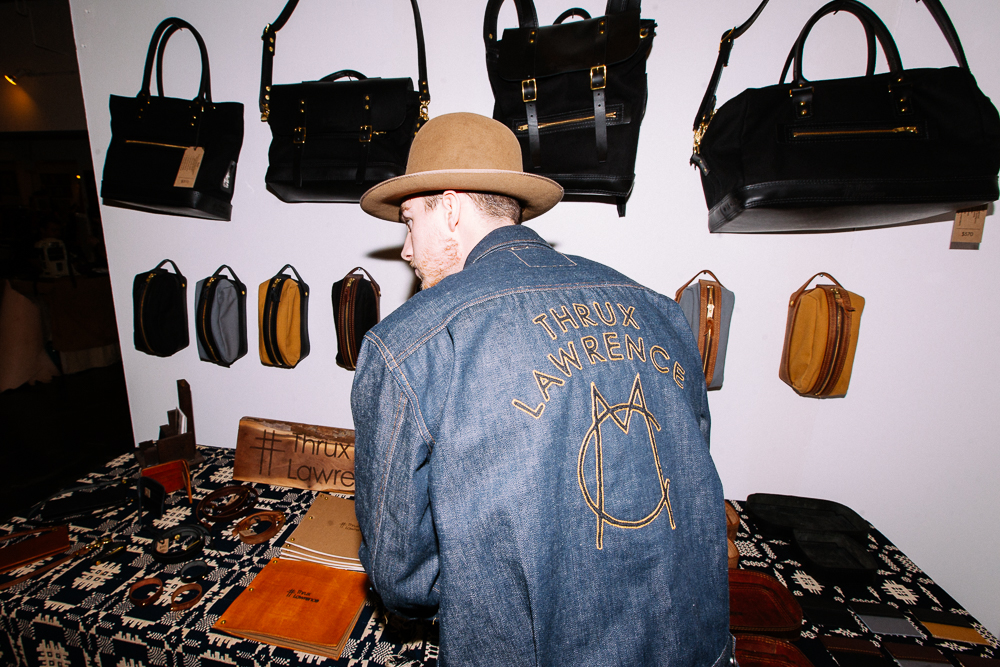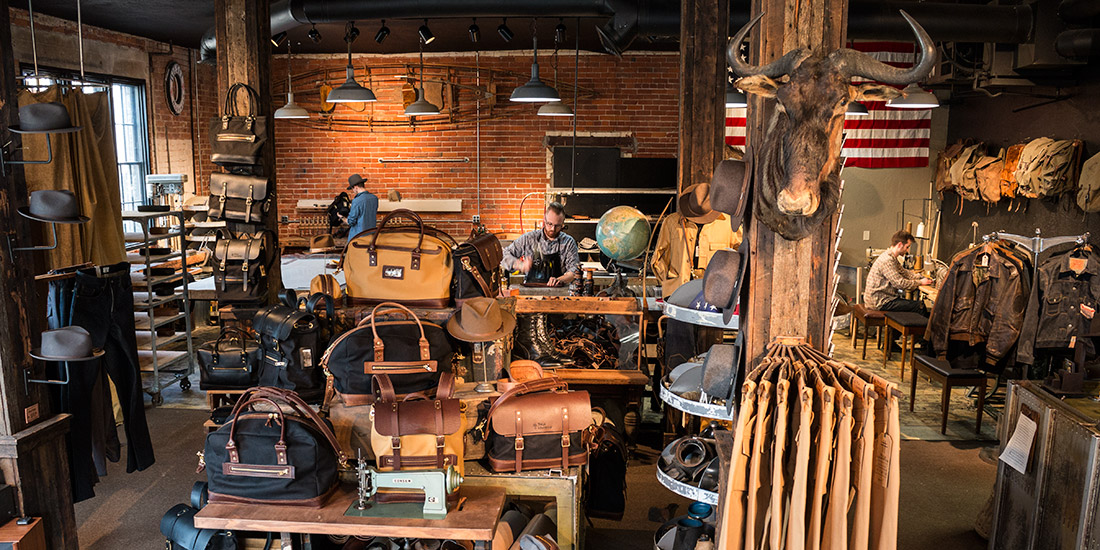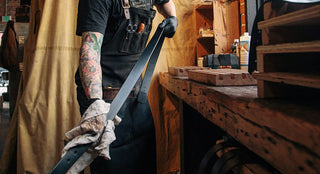Thrux Lawrence is a rustic leather goods retailer that sits on North Third Street, not far from the lake in downtown Coeur d’Alene in Idaho. Resplendent with a barber shop in the back, utilitarian tools of the trade scattered across the space, and other masculine relics from a time long past, proprietor Tanden Launder has a singular vision when it comes to his craft: make something that lasts. Easier said than done? Read on and learn a little bit about his process and inspirations in leather crafting at his handsome open-plan Idaho store.

Tanden Launder of Thrux Lawrence at Inspiration LA a few years back when we visited.
CHONA KASINGER: What attracted you to working with leather?
THRUX LAWRENCE: Growing up, leather was not a common material for my generation—synthetics and nylons were the thing. I think my mum and I shared the hatred for “fake materials.” Therefore, I was raised in a world without plastic. My bags as a boy were very vintage; all leather bags and I collected a lot of African taxidermy. My bike saddles were Brooks and my favorite kicks were and still pretty much are vintage leather Justin Ropers. Leather just came natural to me when I started off in product design.
It takes a unique skill working with something that is not constantly consistent. Being that it’s a natural material, you are always having to read the different characters in the leather and make a judgment call on what’s the best part to use for that particular piece you need. In my world, where there is still literally no plastic, I found that using age-old materials such as leather brings a higher appreciation for the product and that age-old true quality feel. People almost feel like they are being taken back in time, always referencing their grandfather’s old bag or pair of boots.
“It takes a unique skill working with something that is not constantly consistent.”
How did you get linked up with Horween in Chicago?
Horween was on the incline as the leather goods tannery to have your products made out of. From the very beginning, I never considered using another tannery. Being that we were so small, our first order was nothing to concern themselves with and I thought we didn’t have much of a chance. However, after a couple conversations with John at Horween, he came to recognize that we were truly here to make exceptional quality, industrial bags. So the process was started and we waited a long time in high anticipation of it arriving—it was spot on to what I wanted and it made for beautiful first batch bag.

Photo: createdtopursue.com
What are some things that inspire your designs? Was there a particular purchase that influenced your aesthetic earlier on?
My design foundation was naturally inspired from something I admired at one point in my growth as a designer, but I can’t identify many distinct points that inspire me. With design in such volume these days, I think it’s better to develop your own set of guidelines and let your work be guided by what your own beliefs in design are. Some of my basic guidelines are function, material, weight, emphasized detail in structural areas, quality, natural craftsmanship, and that a product or design try to tie itself back to something classic and time-tested.
One of the first vintage items I bought was when I was 12 while in Montana at an antique store. I came across a large shoulder mount wildebeest and named him Lawrence, hence that part of the brand’s name. Kinda funny how it all ties together because… as a teenager, I lived in Africa and currently have another project over in Ethiopia.
“Building these bags by hand one at a time takes hours and hours, and if it’s not right, we correct and use more hours.”
Tell us a little about your process from design to finished product.
Well, it’s a lot of hammers and huge sewing machines with practically nails for needles [and] brute force, all the while looking at our products through a skilled craftsman’s eyes to really navigate the best way to pair materials.
How long does it typically take to see a product all the way to finish?
It really depends on the product. We are by no means a high efficiency production. Building these bags by hand one at a time takes hours and hours, and if it’s not right, we correct and use more hours.

Inside the Thrux Lawrence shop.
Where do you take out-of-towners around Coeur d’Alene? Any favorite spots for vintage shopping in Idaho or elsewhere?
First stop is probably lunch at Hudson’s hamburgers—they have been doing it the exact same way for 100 years, and I appreciate that. The tour of Thrux Lawrence would be second. It’s kinda cool how we set it up; it’s retail up front, showcasing Thrux and supported by a whole bunch of US-made brands and rare vintage items. Over the display counters, customers can see the production—it speaks to the honesty of “nothing’s behind closed doors.” There is no secret to what we do, we are just taking steps that most are not willing to take to build bags as stout as ours. The production noise draws the customer’s ears. Most have never been around production or manufacturing. They are somehow surprised it’s a process of joining one piece to another, one at a time, that will eventually create a finished product.
Next, I try to get them a haircut at my barbershop Bulwark Barber. It sits right next to Thrux Lawrence and I styled it to match something close to the ’30s, pretty much just a cool side project and I got tired of paying for haircuts and sitting in a boring white wall box. The next list of things we would do are never in order, but totally accessible: take the boat out on the lake, bonfire on the beach, head up to the mountains to the look out towers to spend weekends, country road rides on the motorcycles, and a gamut of other Northwestern-ish adventures.
***

